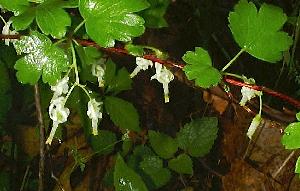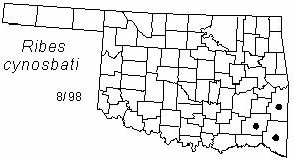
Shrub to 90 cm (3 ft) tall. Crown low and straggling; irregular, diffuse. Twigs tan to brown when young, becoming gray to black with age; pubescent when young, glabrous with age; 2-3 or a single straight spine at the node, about 2 cm (0.8 in) long. Young twigs with numerous small internodal spines. Leaves alternate or fascicled, simple, orbicular or ovate, 3-5 deep lobes, lobes crenate-dentate or incised. Terminal lobes obtuse, lateral lobes rounded, 2.5-5 cm (1-2 in) long and wide; pubescent when young, glabrous with age, truncate, subcordate or rounded at base; petioles 12-25 mm (0.5-1 in) long, pubescent. Flowers in loose racemes, with slender pedicels and peduncles, glandular-ciliate or glabrous, 1-4 flowers per inflorescence; calyx green, campanulate, glabrous; petals 5, inserted at the top of the calyx tube; ovary bristly, style undivided; stamens 5; flowers appear April to June. Fruits berries, armed with prickles, 8-12 mm (0.3-0.5 in) diameter, globose, red-purple, matures July to September.
Distribution: Oklahoma, Arkansas, east to Alabama and North Carolina, north to New Brunswick and Quebec, west to Missouri. Rare in Oklahoma; restricted to the Ouachita Mountains.
Habitat: open rocky woodlands.
Comment: The genus name, Ribes, is derived from the Danish word "ribs" for the red currant; the species name, cynosbati, means dog-berry.
Wildlife benefits: eaten readily by several species of birds.
Horticulture: cultivated since 1759. Prickly gooseberry fruits make excellent jellies. It can be propagated by seed and hardwood cuttings. Prickly gooseberry is an alternate host for white pine blister rust.
NWI status: none
Distribution in Oklahoma: 
BACK
NEXT
RETURN TO INDEX
Last update: 9/17/99
 Go to Oklahoma Biological Survey Home Page
Go to Oklahoma Biological Survey Home Page
 Disclaimer
Disclaimer